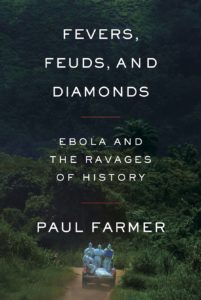Dr. Paul Farmer and three friends toured an Ebola treatment unit (E.T.U.) in Monrovia, Liberia, in October 2014. They watched as two brothers vomited and soiled themselves with diarrhea as they tried to make their way to a ward with beds. One man collapsed.
“His brother squatted beside him,” Farmer writes in his new book, Fevers, Feuds, and Diamonds: Ebola and the Ravages of History, “weeping loudly but tearlessly — probably because he was too dehydrated to make tears.”

Farmer, 59, is a legendary infectious disease specialist and anthropologist with deep roots in Boston. He earned an M.D. and Ph.D. from Harvard, where he is a professor of medicine and chair of the dept. of global health and social medicine. He heads the global health division at Brigham and Women’s Hospital. In 1987, he co-founded Partners in Health (P.I.H.), a Boston-based nonprofit working to modernize medical care in poor and sick communities around the world. Farmer received a MacArthur Fellowship in 1993 for his work with P.I.H. and procuring low-cost, cutting-edge drugs to fight HIV. He has continued a jaw-dropping routine of clinical work — travel, speaking, teaching, and publishing.
Even with his wealth of experience in devastatingly difficult environments, Farmer writes, he was unprepared for what he saw at the E.T.U. in Liberia. He and his team “knew that the treatment for the brothers’ immediate emergency — the loss of fluids and electrolytes — had been worked out during the world war that had started exactly a century previously. We looked on, fearing that yet another early twenty-first-century family was being undone by a failure to deliver early twentieth-century therapies.”
Farmer is quick to dismiss Richard Preston’s The Hot Zone: The Terrifying True Story of the Origins of the Ebola Virus, which he calls “hyperbolic.” Preston asserts that Ebola causes internal hemorrhaging, but Farmer notes that this headline-catching effect doesn’t even make it into the top 10 symptoms patients experience. Neither does eating bats feature prominently in contagion.
“Medical modesty is warranted in considering outbreaks of Ebola,” Farmer writes, “since the disease is spread by acts of caregiving,” including washing and burying the dead.
What is terrifying and true, Farmer explains, is that between 2014 and 2016 in Liberia, Sierra Leone, and Guinea, the Ebola virus killed more than 11,000 people because they lived in “medical deserts,” where blood draws, diagnostic labs, and I.V. fluids were nowhere in sight. The virus killed more than half of the 1,000 health care professionals treating Ebola patients in these West African nations for the simple reason that they lacked adequate protective gear — what we call P.P.E. in Covid times.
Farmer is at his brilliant best in Fevers, Feuds, and Diamonds when he puts his anthropology training to work. He interviews two Sierra Leonean survivors of Ebola, who explain to him how they and their families were destabilized and dislocated over generations by the ravages of war. They provide granular details of living on the margins of multinational corporate ventures, which never invest in hospitals or schools but always provide just enough infrastructure to remove rubber, diamonds, or palm oil. These stories, Farmer writes, “are vital for us to hear, because they can provide a powerful understanding of Ebola, and the structural forces that made it so deadly.”
Farmer’s analyses of those structural forces are astute. West Africa needed “highly trained staff, clean and well-maintained operating rooms (safe space), an uninterrupted flow of supplies (lots of stuff, including instruments, anesthetics, and blood products), and ongoing attention to infection control (systems).” He includes plenty of snark: “The polite euphemism that described these as being in short supply or ‘limited’ in Sierra Leone made it sound as if the country were a temporarily understocked Sweden.” In another moment of candor, he applies the word “shithole” to a Sierra Leonean hospital. “That’s not a term to be used in describing countries or continents,” he writes, “but it was the mot juste for the hospital in Kenema.” It’s impossible not to appreciate Farmer’s insider’s gallows humor when, in an aside, he notes that local authorities had declared an area “Ebola-free,” but it “was also lab-free. So who was to know?”
This is not to say Farmer’s book is an unqualified success. After he mixes up Sierra Leone and Liberia in a pre-dawn hotel phone call, he goes down a self-admitted “rabbit hole” of history, a “personal penance” intended “to make amends for my ignorance. Even at four in the morning, it’s not right to mix up Liberia and Sierra Leone.” That penance is four long chapters that chart “West Africa’s thorough integration into a global economy of extraction,” he writes. “If you want to understand the magnitude and dynamics of this Ebola epidemic, in other words, think in terms of fevers, feuds, and diamonds.” I skimmed.

Farmer put the finishing touches on his book this past April, as he and P.I.H. staff met with Gov. Charlie Baker to set up contact tracing for Covid. In his prologue and epilogue, he notes the many parallels between Ebola and the novel coronavirus, from lack of protective gear to governmental unpreparedness. Though Farmer has been trying to increase access to medical care for 30 years, he has yet to see meaningful change in the U.S.
There are some bright spots around the globe. He was heartened when, in 2018, officials in Congo moved quickly to administer a new vaccine in a community where Ebola was spreading. The vaccine needed to be kept refrigerated at 80 degrees below zero Celsius. Cell phone coverage and passable roads were needed to reach patients. Within a month of the outbreak, 700 doses of the vaccine had been administered, and the area had a new cell tower. “It’s hard,” Farmer writes, “to regard either vaccination or tower erection as stunning achievements when one considers the Congo’s role in supplying fissile materials for the nuclear age.”
American readers may experience similar feelings of dismay as they grind through month 10 of the pandemic.
